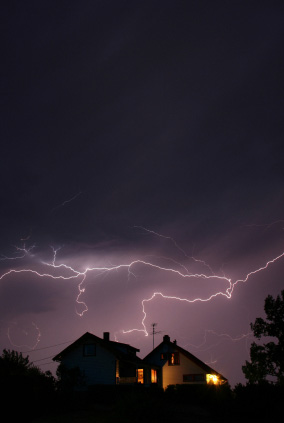What’s the best lightning protection for your home?
Emmet Pierce
Each year lightning strikes cause hundreds of millions of dollars in property damage, while claiming dozens of lives throughout the U.S.
During Lightning Safety Awareness Week, June 23 to 29, the National Oceanic and Atmospheric Administration NOAA), hopes to raise public consciousness. Insurance companies share NOAA’s desire to raise awareness, since lightning strikes often lead to costly home insurance claims.
 Most standard home and business insurance policies cover property damage caused by lightning, says Dennis Hilton, an independent insurance agent in Maine.
Most standard home and business insurance policies cover property damage caused by lightning, says Dennis Hilton, an independent insurance agent in Maine.
“Lightning is one of the core perils that insurance policies are designed to protect against,” he says.
Pete Moraga, a spokesman for the Insurance Information Network of California, says your car will be covered for lightning damage, if you have a comprehensive auto policy. Comprehensive insurance protects your vehicle from such things as theft, vandalism, and damage from severe weather conditions.
An analysis by the nonprofit Insurance Information Institute III) found that lightning damage was responsible for an average of about $960 million in property claims annually, between 2007 and 2011.
The average lightning claim was $5,112 in 2011, up 5.5 percent from 2010, the III reports.
The average cost for each claim rose 93 percent between 2004 and 2011. The total number of claims paid by insurers declined by about one third during this period, however. That decline may be due to increased use of lightning protection systems, which can reduce damage from lighting strikes.
What’s the best lightning protection for your home?
The installation of protection systems, which are designed to intercept lightning strikes and carry the electrical current safely to the ground, can reduce the potential for damage, says III spokesman Michael Barry. Such systems should be installed by professionals. They typically include the use of lightning rods. The systems are designed to guide the electrical current safety to the ground, away from the home and its occupants.
Kim Loehr, communications director of the nonprofit Lighting Protection Institute, says costs for such systems vary widely. The cost for protecting a single-family home can range between $1,800 and $3,500, she adds.
If you are considering the installation of a lightning protection system, Barry says you should check with your insurance agent or broker to find out if it would entitle you to a property insurance discount. Also take time to check the credentials of the business or contractor that installs the system.
Summer is the peak time for lightning strikes
While lightning can strike during any season, summer months are the peak time. One of the most common lightning-related claims is for damaged electronic equipment, Moraga says.
A typical surge protector won’t protect electrical equipment from damage during a lightning storm. Hilton says the large number of electronics in most homes today makes them very susceptible to such damage Any device that can be plugged into an electrical outlet is vulnerable.
How to stay safe when there’s lightning
There is no safe place outdoors when there are lightning storms. According to NOAA, if you can hear thunder, you probably are within range of a lightning strike.
If you are driving during a lightning storm, NOAA advises you to pull onto the shoulder of the road, away from any trees that could fall on the vehicle. Remain inside the car.
The metal exteriors of automobiles with hardtops typically protect vehicle occupants during lightning storms. Those inside should keep the windows closed and avoid touching metal objects that may conduct electricity. When striking cars, lightning usually passes through the tires to the round, leaving occupants unharmed.
Fatalities due to lightning strikes increased from 26 in 2011 to 28 in 2012, NOAA reports.
About a dozen deaths each year are attributed to fires caused by lightning.
“Lightning is super powerful electricity that can pack 100 million volts of power,” says Loehr.
When lightning hits dwellings, people who are using landline telephones or computers frequently are injured, she adds. According to the National Weather Service NWS), there are three primary ways that lightning can enter your home: through a direct strike, through wires or plumbing that extend outside or through the ground.
People who are hit by lightning should receive medical attention as soon as possible.
When a person is struck, immediate injury symptoms can include cardiac arrest, difficulty breathing, burns, short-term memory loss, slower reaction times, distractibility, irritability, forgetfulness, intense headaches and problems with performing complex tasks.
Long-term symptoms may include chronic pain, loss of balance, seizures and depression.
7 lightning safety tips
Here are 7 NWS safety tips for protecting your dwelling and its occupants during a lightning storm:
- Don’t stand close to windows and doors.
- You can use mobile phones, but avoid using phones with cords.
- Don’t touch electrical equipment or attempt to unplug electronics.
- Stay away from plumbing until the storm has passed. Don’t wash your hands, shower, wash dishes or do laundry. Washers and dryers not only have contacts with plumbing and electrical systems, but also contain an electrical path from the outside through their dryer vents.
- Don’t lie on concrete floors or lean against concrete walls, which may contain metal reinforcement bars that conduct electricity.
- Bring pets indoors.
- If your home is struck, inspect it for damage and possible fires. If you see smoke or fire, evacuate and call 911.
See how much you could save today on your home insurance. Get your free home insurance quotes today!
